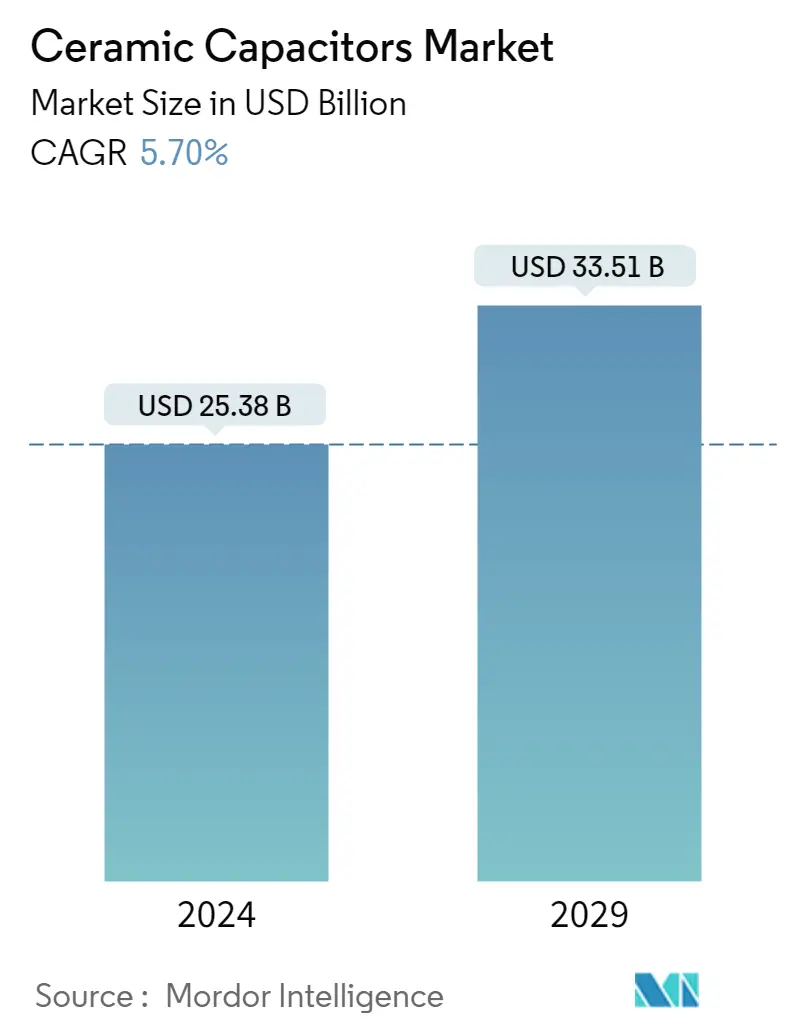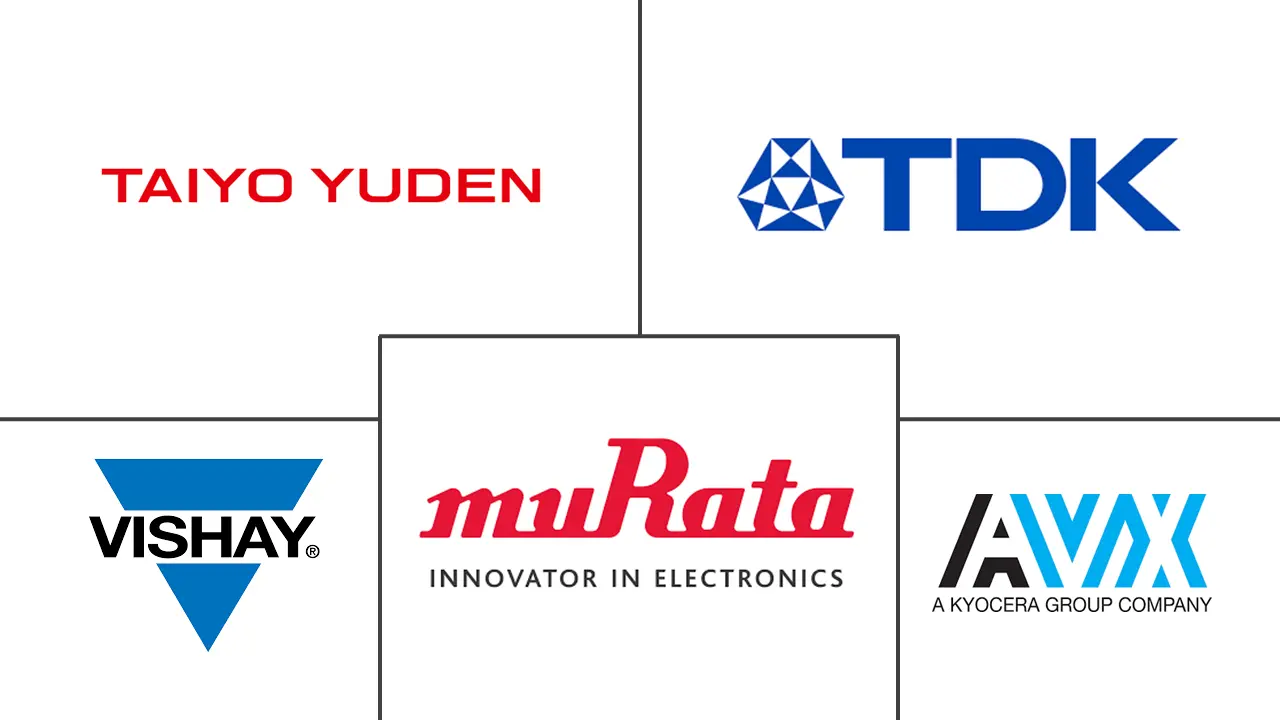Market Size of Ceramic Capacitors Industry

| Study Period | 2019 - 2029 |
| Market Size (2024) | USD 25.38 Billion |
| Market Size (2029) | USD 33.51 Billion |
| CAGR (2024 - 2029) | 5.70 % |
| Fastest Growing Market | Asia Pacific |
| Largest Market | Asia Pacific |
| Market Concentration | Medium |
Major Players
*Disclaimer: Major Players sorted in no particular order |
Ceramic Capacitors Market Analysis
The Ceramic Capacitors Market size is estimated at USD 25.38 billion in 2024, and is expected to reach USD 33.51 billion by 2029, growing at a CAGR of 5.70% during the forecast period (2024-2029).
Ceramic capacitors are one of the most commonly used in most electrical instruments, as they offer reliability and are cheaper to manufacture. These capacitors are used in multiple industries and primarily consist of ceramic or porcelain discs that exist in a non-polarized form. The ceramic material is also an excellent dielectric due to its poor conductivity and its efficient support of electrostatic fields.
- Ceramic capacitors are mostly available in three types. However, other styles are also available: leaded disc ceramic capacitors for through-hole mounting, resin-coated surface mount multilayer ceramic capacitors (MLCC), and special type microwave bare lead-less disc ceramic capacitors, which are primarily intended to sit in a slot on the PCBs.
- Among the applications, MLCCs are essential components of many electronic devices and are widely used in such devices as wearable devices and smartphones (approximately 900 to 1100 multilayer ceramic capacitors are installed in a smartphone).
- Also, there has been a shift in preference in electronics from consumer electronics to computing. The emergence of AI, IoT, cloud, and digitalization has led manufacturers to concentrate on this segment. These new technologies have a high profit margin compared to consumer goods, and the units needed are also fewer, making it viable for manufacturers to manage their production lines.
- The widespread adoption of 5G smartphones and their increasing functionality are stoking demand for further miniaturization and higher electronic circuitry density. For instance, a number of companies, including Qualcomm and MediaTek, are releasing chipsets that support 5G, and numerous smartphone manufacturers are using them. Previously, 5G support was confined to only flagship mobiles; now, mid-level smartphones also support 5G to introduce cheaper chipsets in the market. Such initiatives are increasing the need for ceramic capacitors.
- On the flip side, the production of ceramic capacitors presents several challenges. One major challenge is manufacturing high-capacitance multilayer ceramic capacitors (MLCCs), which involves stacking many single-layer capacitors into a single package. The manufacture of these capacitors is fraught with problems, including mechanical susceptibility, cracking during surface-mount soldering to a circuit board, and difficulty achieving high uniformity of capacitance across the layers. Another challenge is capacitance's temperature and frequency dependence, which can cause issues in high-performance applications.
- The COVID-19 pandemic impacted the ceramic capacitor market. The pandemic caused disruptions in the supply chain and manufacturing processes, leading to fluctuations in the demand and supply of ceramic capacitors.
- However, the market was anticipated to recover as the situation normalized with the ongoing vaccination drives and relaxed regulations. Meanwhile, ceramic capacitor components were expected to witness a growing demand from other industries due to an increasing demand for consumer electronics and mobile devices, such as laptops and computers, due to the work-from-home scenario across the world. Also, significant demand was witnessed from the increasing trend of online gaming during the pandemic, which subsequently increased the demand for gaming and home theater electronics.
Ceramic Capacitors Industry Segmentation
Ceramic capacitors are made of ceramic material as dielectric. These capacitors comprise two or more layers of ceramic and a layer of metal acting as electrodes. The composition of the ceramic material determines its electrical behavior and, therefore, its applications. Layers of ceramic and a layer of metal act as electrodes. The composition of the ceramic material determines its electrical behavior and, therefore, its applications. Ceramics are inorganic, crystalline oxide, non-metallic nitride, or carbide compounds like silicon and carbon.
The ceramic capacitors market is segmented by type (MLCC, ceramic disc capacitor, feedthrough ceramic capacitor, ceramic power capacitor), end-user (consumer electronics, automotive, telecommunication, industrial, energy & power, and other end-users), and geography (North America, Europe, Asia-pacific, Latin America, and, Middle East and Africa). The market sizes and forecasts are provided in terms of value (USD) for all the above segments.
| By Type | |
| MLCC | |
| Ceramic Disc Capacitor | |
| Feedthrough Ceramic Capacitor | |
| Ceramic Power Capacitor |
| By End-User | |
| Consumer Electronics | |
| Automotive | |
| Telecommunication | |
| Industrial | |
| Energy & Power | |
| Other End-Users |
| By Geography | |
| North America | |
| Europe | |
| Asia-Pacific | |
| Latin America | |
| Middle East and Africa |
Ceramic Capacitors Market Size Summary
The ceramic capacitors market is poised for significant growth, driven by their widespread application across various industries due to their reliability and cost-effectiveness. These capacitors, primarily composed of ceramic or porcelain discs, are integral to numerous electronic devices, including smartphones and wearable technology, where they serve as essential components. The market is experiencing a shift towards computing and advanced technologies such as AI, IoT, and 5G, which demand higher electronic circuitry density and miniaturization. This shift is further fueled by the increasing adoption of 5G smartphones and the need for more compact and efficient electronic components. However, the production of high-capacitance multilayer ceramic capacitors (MLCCs) presents challenges, including mechanical susceptibility and temperature dependence, which can impact their performance in high-end applications.
The automotive sector is a significant driver of demand for ceramic capacitors, particularly with the rise of electric vehicles (EVs) and advanced driver-assistance systems (ADAS). The need for reliable and compact electronic components in vehicles, coupled with the growing trend towards autonomous and connected cars, is propelling the market forward. The Asia-Pacific region, especially China and Japan, plays a crucial role in this market due to its expanding automotive industry and early adoption of electric vehicles. Additionally, the telecommunications industry in this region is witnessing increased demand for ceramic capacitors, particularly MLCCs, due to their high capacitance and voltage tolerance. Key players in the market are engaging in strategic partnerships and product innovations to enhance their market share and meet the evolving demands of various industries.
Ceramic Capacitors Market Size - Table of Contents
-
1. MARKET INSIGHTS
-
1.1 Market Overview
-
1.2 Industry Attractiveness - Porter's Five Forces Analysis
-
1.2.1 Bargaining Power of Suppliers
-
1.2.2 Bargaining Power of Buyers
-
1.2.3 Threat of New Entrants
-
1.2.4 Threat of Substitutes
-
1.2.5 Intensity of Competitive Rivalry
-
-
1.3 Value Chain Analysis
-
1.4 Macro-economic Assessment Including Post-COVID-19 Analysis
-
-
2. MARKET SEGMENTATION
-
2.1 By Type
-
2.1.1 MLCC
-
2.1.2 Ceramic Disc Capacitor
-
2.1.3 Feedthrough Ceramic Capacitor
-
2.1.4 Ceramic Power Capacitor
-
-
2.2 By End-User
-
2.2.1 Consumer Electronics
-
2.2.2 Automotive
-
2.2.3 Telecommunication
-
2.2.4 Industrial
-
2.2.5 Energy & Power
-
2.2.6 Other End-Users
-
-
2.3 By Geography
-
2.3.1 North America
-
2.3.2 Europe
-
2.3.3 Asia-Pacific
-
2.3.4 Latin America
-
2.3.5 Middle East and Africa
-
-
Ceramic Capacitors Market Size FAQs
How big is the Ceramic Capacitors Market?
The Ceramic Capacitors Market size is expected to reach USD 25.38 billion in 2024 and grow at a CAGR of 5.70% to reach USD 33.51 billion by 2029.
What is the current Ceramic Capacitors Market size?
In 2024, the Ceramic Capacitors Market size is expected to reach USD 25.38 billion.

